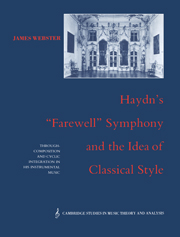 Haydn's 'Farewell' Symphony and the Idea of Classical Style
Haydn's 'Farewell' Symphony and the Idea of Classical Style Summary
In 1985–86, while in Vienna on sabbatical, I received a pair of invitations to travel to Budapest to lecture on Haydn. This stimulated me to begin a long-postponed study of the “Farewell” Symphony, in part because I could combine it with an examination of Haydn's autograph manuscript (housed, like so many, in the National Széchényi Library in the same city). I am lastingly grateful to László Somfai and Katalin Komlós for extending these invitations (and for much else besides), as well as to Zoltán Felvy, director of the Institute of Musicology of the Hungarian Academy of Sciences, and György Króo, chairman of the Department of Musicology of the Ferenc Liszt Academy of Music, for financial and logistical support. I am equally grateful to Veronika Vavrinecz, head of the Music Division of the Library, for her unexcelled kindness and cooperation. Later, I gave related lectures at chapter meetings of the American Musicological Society – New York State-St. Lawrence (1988) and Greater New York (1989) – and at King's College, London (1988).
As background for the Budapest lectures, I carried out an extended analysis and interpretation of the symphony, as well as a largely independent study of the baffling D-major interlude in the Allegro assai. (For the latter, which incorporates several detailed discussions omitted from the present study, see the Introduction, n. 9.) I also made extensive studies of Haydn autograph materials that year in Vienna, particularly at the Gesellschaft der Musikfreunde in Wien (relevant in this context especially for the string quartets Op. 20); I remain most grateful to Dr. Otto Biba, director of the archive, for his exemplary assistance and support.
- Type
- Chapter
- Information
- Haydn's 'Farewell' Symphony and the Idea of Classical StyleThrough-Composition and Cyclic Integration in his Instrumental Music, pp. xv - xviiPublisher: Cambridge University PressPrint publication year: 1991
